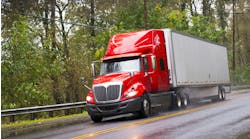MONTREAL, QUE. Platooning is just one step in truck automation that is expected to boost fuel efficiency and safety for commercial fleets. But in order for heavy-truck platooning to truly work in the real world, the industry has a lot of challenges to overcome.
During a panel discussion at Michelin’s Movin’On sustainable mobility summit, Michael Roeth, executive director of the North American Council for Freight Efficiency (NACFE), explained that at about a 50- or 60-ft. following distance, two-truck platooning could deliver a fuel savings of 10% for the second truck in the platoon and between 4-5% for the lead truck.
Roeth said platooning is a natural step in truck automation since it builds on the technology that is already being purchased on trucks.
“Safety equipment like automatic braking and lane keeping are options fleets can buy on their trucks, and they are being bought on a pretty high scale with no regulations requiring them,” he explained. “A lot of the technology that is required to platoon two trucks is already on the truck. Now we just have to figure out how to handle the vehicle-to-vehicle communication.”
Roeth stressed that platooning has been mistakenly grouped as “the fully autonomous, self-driving truck,” which has turned some people off from the discussion. Roeth said that’s not the case and added there are still opportunities to have the driver in the truck.
But before platooning could make it into real-world applications, the industry still must determine whether fleets and drivers will use the technology, whether the public will accept it, and what will happen on the regulatory front.
Bill Brentar, vice president of maintenance and engineering for UPS, noted another challenge is fitting platooning into normal fleet operations.
“One of the challenges is you don’t platoon everywhere – for instance there are only 45,000 platooning miles in the U.S. – so where are those miles and how do they fit into your operations?” he pointed out.
“You almost have to have ‘platooning on the fly’ because you don’t have people matched up to park at the same time or meet at the same time every day, so if you don’t have platooning on the fly, it limits the amount of miles you can platoon,” he added.
Shad Laws, vice president of product planning at Peloton Technology, said the real challenge he sees is convincing drivers platooning is something they want to use.
Platooning allows trucks to follow at distances that are impossible to be safe for even the most expert drivers, Laws explained. He added there is a significant lag in reaction time for a safe human driver compared to platooning radar and active-braking technology.
“One of the keys to our system is truly a driver-centric design,” Laws said. “Convincing a fleet owner is easy. Convincing drivers that this is something good and that they want to use is hard.”
In Europe, Bernard Jacob, deputy scientific director at the French Institute of Science and Technology for Transport (IFSSTTAR), projects that platooning technology will be ready by 2025. He noted, however, that appropriate legislation is still needed.
A new project on platooning will be launched next week in Europe and is expected to last for about three years. The goals of the project are to study platooning in real-world conditions, and to assess the impacts on road infrastructure, driver and truck safety, and traffic flow.
Christian Bergstrand, program manager for Scania, explained that Scania is developing most of its own technology itself. Right now, Bergstrand said Scania is using adaptive cruise control and teaching its customers how to use platooning technology.
He explained that the next step for the company is to focus on vehicle-to-vehicle communications to increase safety and eventually shorten the distance between vehicles for optimal fuel efficiency. He also added that the end goal in Europe would be removing the driver from controlling the vehicle.
“We strongly believe platooning will be the use case for completely autonomous vehicles down the road,” he said.





